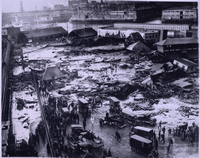 At 12:40 p.m. on January 15, 1919, residents in the North End area of Boston heard the sound of an explosion as a fifty foot tall tank containing over two million gallons of molasses collapsed. In seconds, a wall of molasses rushing from the tank reached fifteen feet high and began to pour through the streets in the neighborhood around the tank. The sticky substance traveled up to 35 miles per hour carrying with it a force equivalent to 2000 pounds per square inch. As the wave moved through the streets it lifted a train off of its tracks, knocked buildings from their foundations and swept bystanders away. Once it stopped flowing, the molasses was two feet deep throughout the area. In the aftermath twenty one people were killed and another 150 were injured in the incident.
At 12:40 p.m. on January 15, 1919, residents in the North End area of Boston heard the sound of an explosion as a fifty foot tall tank containing over two million gallons of molasses collapsed. In seconds, a wall of molasses rushing from the tank reached fifteen feet high and began to pour through the streets in the neighborhood around the tank. The sticky substance traveled up to 35 miles per hour carrying with it a force equivalent to 2000 pounds per square inch. As the wave moved through the streets it lifted a train off of its tracks, knocked buildings from their foundations and swept bystanders away. Once it stopped flowing, the molasses was two feet deep throughout the area. In the aftermath twenty one people were killed and another 150 were injured in the incident.
Clean up efforts began immediately but it would be four months before the last of the molasses was removed from North End. Today a recreational complex sits on the site of the tank explosion.
A sign at the entrance of the park reads: “Boston Molasses Flood - On January 15, 1919, a molasses tank at 529 Commercial Street exploded under pressure, killing 21 people. A 40-foot wave of molasses buckled the elevated railroad tracks, crushed buildings and inundated the neighborhood. Structural defects in the tank combined with unseasonably warm temperatures contributed to the disaster.”
